ONGOING drought presents a constant dilemma: do farmers get rid of livestock or put them on feed, hoping the weather will break? The latter is costly, not only in feed but also in labour. Feeding stock every day is a laborious task and buying self-feeders is prohibitively expensive for those with big flocks or herds.
At least it was until young Walgett farmer and welder Joey Fleming came up with an ingenious solution that saves both money and materials. He’s just finished converting two 40-foot (12.2m) shipping containers into feedlots, each holding a massive 30 tonnes of grain.
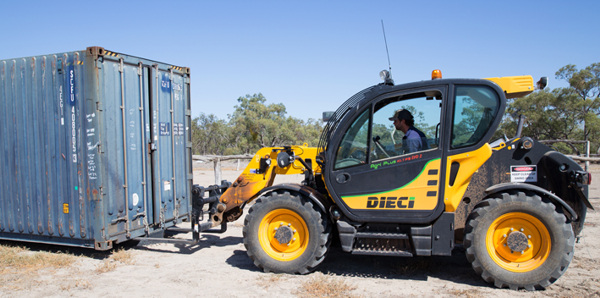
Joey uses an agricultural telehandler to move the heavy shipping containers.
RISING TO THE CHALLENGE
Joey was commissioned to do the conversion by his mate Justin O’Brien who runs a lamb feedlot at nearby Cryon Station. Justin had heard of people using containers as feeders and also seen grain delivered using side-delivery trailers with a V in the floor to help it slide out. He wondered if a similar system could be installed in a shipping container. “I thought it was a bloody ripper of an idea!” says Joey, who runs
Ulah Engineering from a shed on his family property, Ulah in Walgett.
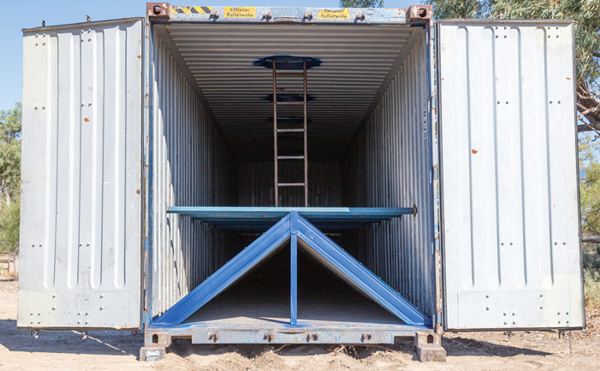 The inside of the container features a triangular prism on the floor to filter the grain into the trough.
The inside of the container features a triangular prism on the floor to filter the grain into the trough.
It has been a skilled challenge. “The internal structure of the shipping container, unlike other grain feeders, uses a solid triangular prism structure on the floor to direct the grain towards the walls,” he explains.
“Slots have been cut out of the walls for the grain to flow out and that flow rate is adjustable with sheet steel doors. The grain is collected in a small trough at the bottom of the doors to minimise wastage, [a critical feature during drought]. Holes have been cut out of the top of the container, then capped for ease of filling and to ensure there are no water leaks.”
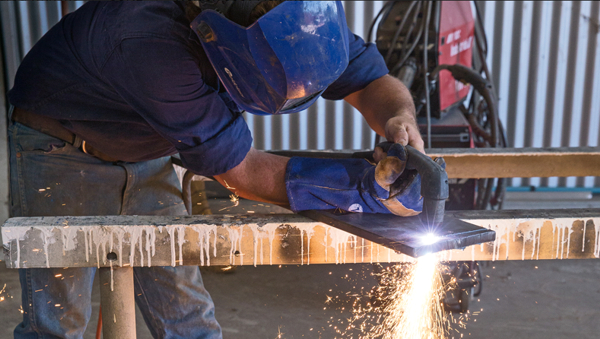
Joey at work sparking up a storm while welding in his shed
IDEAS FOR CLEVER FEEDING
Justin is delighted and can already see that the shipping container feeders have many advantages. For a start, with two, he can bolt on a shade roof between them, thus saving on the labour and materials needed to build a normal shade roof with piers and foundations. That’s crucial, as the O’Briens’ feedlot trials have shown that sheep in the shade will put on 20 to 30g more per day than those that are stressed out by the sun.
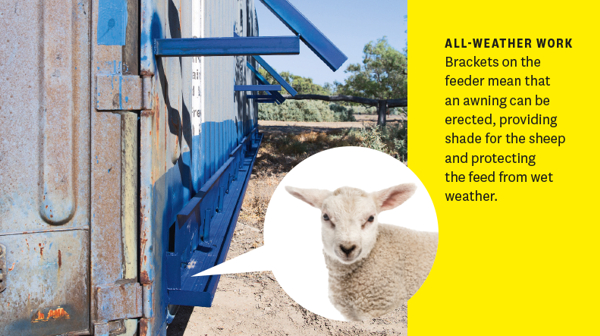
Then, of course, there’s the practical aspect. “If we have 600 sheep in a pen we’ll fill the bins once and they’ll be right for an eight-week cycle, which is basically the whole time they’re in the feedlot,” Justin explains. “That’s good for us because we’ll know exactly how much they’ve eaten and it’s less labour which is our main
cost these days.”
He also points out that, while mainly grain farmers have chaser bins to fill up feeders, other farmers who don’t have grain storage could find a 30-tonne shipping container feedlot useful, particularly during drought. Having stockfeed storage reserves or supplement feeders in the paddock wouldn’t go astray.
LIVESTOCK COST SAVINGS
Most importantly, there’s the cost. The alternative to the container feedlots was to buy six silo feeders, each of which would have held only 4.5 to 5 tonnes of grain. The two shipping containers will hold 60 tonnes of grain between them.
“Usually feeders cost around $1,000 per tonne,” explains Joey. “This will work out at about $500 per tonne.” That includes the cost of the two containers at around $5,000 each and the conversion cost of around $11,000 each.
“I think it’s revolutionary,” Joey continues. “The amount of time farmers put into feeding their sheep, running to and from different parts of their place every day or week… It’s an arduous, time-consuming task. This could be used anywhere.”
“You just have to put it on the back of a truck, dump it in the paddock, put 30 tonnes of food in there and you know you’re going to be right for a month at least. All you need to do is check their water,” Joey says.
COMMUNITY-MINDED BUSINESS
This isn’t the first time Joey’s handiwork has impressed Walgett locals. He recently finished a coffee cart designed to look like a small horse float for his partner Emily Wilson who owns a catering business called
Silo & Co. “It appeals nicely to the rural scene and people really go for it,” he says. “She takes it to anything from campdrafts to weddings.”
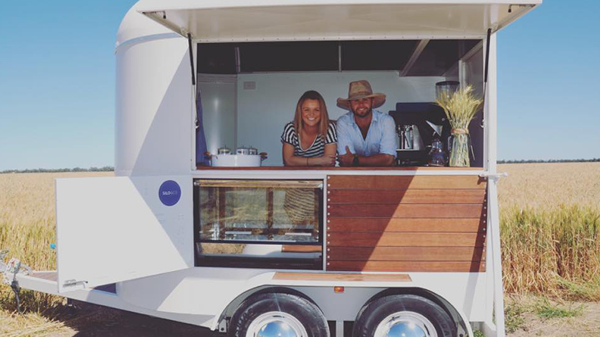 Joey, with his partner Emily Wilson, converted a horse float to a mobile coffee cart for Emily’s business Silo & Co. Image courtesy: Silo & Co Facebook page
Joey, with his partner Emily Wilson, converted a horse float to a mobile coffee cart for Emily’s business Silo & Co. Image courtesy: Silo & Co Facebook page
He’s also used shipping containers to make sheds, including the plane hangar on his farm, and has customised musterers’ quad bikes to make them more practical – welding on bull bars and cages so there’s room for three or four dogs or somewhere to put a lamb that needs assistance.
His latest investment is a CNC plasma cutting machine, so he can now produce farm signs, mailboxes or any intricate metal part.
Joey, who also grows wheat, cotton and chickpeas, says of his Ulah Engineering venture: “It’s good to keep yourself entertained and have different avenues to keep your brain going. It’s not going to make me a millionaire, but it opens up different avenues of income. I’ll give anything a go.”